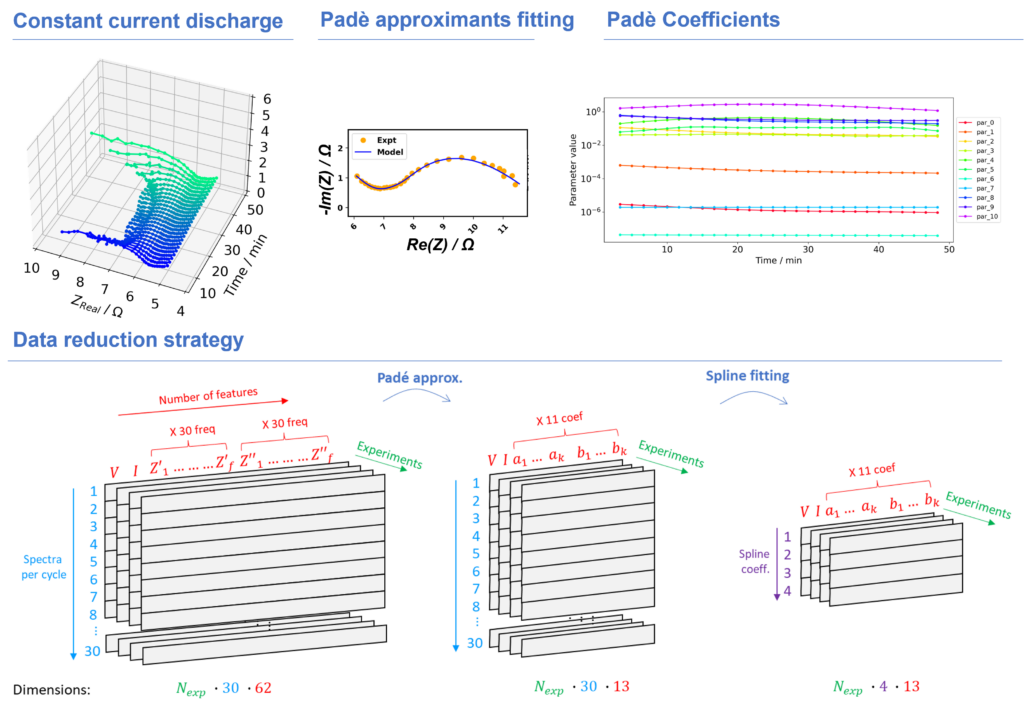Determination and prediction of the state of health (SOH) of a battery are crucial for the optimization of its usage and increase of lifetime.
In the Fraunhofer Attract project “ProLIBs: A Battery Cell ID Card”, the goal is the prediction of the aging behavior of NMC-based batteries under different operating conditions utilizing its characteristic impedance. Advanced characterization techniques and statistical analysis methods are used to predict the SOH and state of charge (SOC) of a cell and understand the aging processes.
NMC electrodes are fabricated in-house with custom formulations and coupled with graphite anodes to assemble batteries in “pouch” cell format, a geometry close to commercial designs.
A physical model is in development to describe the intercalation reaction in a porous electrode and the effect of the interfaces using microscopic average quantity to represent the macroscopic electrodes’ properties. In parallel, an advanced experimental method is used to measure the impedance of the cell during the charge and discharge. The impedance, acquired over a broad frequency band, contains qualitative and quantitative information on the characteristics physico-chemical processes. The experimental set-up is fully automatized to allow the continuous impedance determination at any moment of the cycling.
The key idea of the project is to use the experimental data to obtain the values of the physical quantities in the model by regression. In particular, impedance data are transformed to Padé approximant coefficients reducing the dimensionality of the set while keeping the same information.
A further dimensionality reduction is obtained using spline functions while keeping the minimum non-redundant information of the system (i.e., the degrees of freedom). Then these data can be used as advanced features in machine learning algorithms for state of health prediction, which are currently under study in the group.
The experimental data can also be combined with the physical models in physics-informed neural networks (PINNs) in order to expand the predictions range to non-measurd conditions like temperatures or load profiles.
The universality of the approach offers the advantage of transferring the results to completely new cell types (e.g., solid-state batteries) with little effort. By implementing it in the battery management system, the data for the lifetime prediction can be obtained during the operation of the system. This data can be used to develop optimized charging strategies, which increases the overall life of the battery system.
This project is conducted by the Modelling and Simulation group of Fraunhofer IFAM led by Prof. La Mantia.

Publications
- Hallemans, N., Howey, D., Battistel, A., Saniee, N.F., Scarpioni, F., Wouters, B., La Mantia, F., Hubin, A., Widanage, W.D., Lataire, J., 2023. Electrochemical impedance spectroscopy beyond linearity and stationarity—A critical review. Electrochimica Acta 466, 142939. https://doi.org/10.1016/j.electacta.2023.142939
- Scarpioni, F., Khalid, S., Chukwu, R., Pianta, N., La Mantia, F., Ruffo, R., 2023. Electrochemical Impedance Spectroscopy for Electrode Process Evaluation: Lithium Titanium Phosphate in Concentrated Aqueous Electrolyte.
ChemElectroChem. https://doi.org/10.1002/celc.202201133 - Pianta, N., Scarpioni, F., Chukwu, R., La Mantia, F., Ruffo, R., 2023. Evaluation of kinetic parameters of non-faradic processes in carbon-based electrodes using multisine dynamic electrochemical impedance spectroscopy.
Electrochimica Acta 437, 141462 (2022) https://doi.org/10.1016/j.electacta.2022.141462
| Funding institution and program: | Fraunhofer IFAM |
| Grant agreement number: | Attract 028-602604 |
| Project acronym: | ProLIBs |
| Coordinator of the Consortium: | Prof. Fabio La Mantia |
| Host Institution (HI): | Fraunhofer IFAM |
| Funding: | 2,490,773€ |
| Duration of the project: | Start date: 2020-07-01 End date: 2023-12-31 |